Notes: At Roudham Junction the branch line to Watton and Swaffham left the Thetford to Norwich main line. A Bill allowing construction of the Norwich & Brandon Railway was granted Royal Assent on 10 May 1844 and work began the same year. Some writers, in detailing the history of the Great Eastern Railway, assert that a station was built at Roudham, lying east of Thetford and west of Harling stations and opened at the same time as the line on 30 July1845. The Thetford & Watton Railway was granted consent to build a railway from Roudham to Watton in the mid 1860s. It opened to goods traffic in January 1869 and to passengers in October of that year. It has been said that at the same time Roudham station was renamed Roudham Junction. A station at this location was not accessible to the public other than by the railway. This fact possibly throws up some questions as to the accuracy of historical accounts and the reason for constructing a station there before it became a junction. There is no evidence that Roudham Junction offered a service to the public for the carriage of goods. Old maps show no goods facilities and the absence of roads further bears this out. Goods traffic to and from the branch was no doubt shunted and possibly transferred at the station. In 1932 the daily goods was worked from King’s Lynn, departing at 7.45am and terminated at Roudham, returning from there at 2.15pm.
 From 1 October 1902 Roudham Junction was advertised as an exchange station only, to be used by passengers changing trains to or from the branch line. The 1882 and 1905 OS 25in Maps show the layout of the station, as a junction, in some detail. The station lay in an east:west direction. On the south side of the main line there was a platform with a small building that was probably a shelter. The other platforms were on each side of an island on the north side of the main line. A large signal box was constructed at the east end of the island. Beside it, seen in photographs from the 1920s, was a smaller building to its west, adorned with advertisements, that probably served as the station office.; this building had gone by the 1950s. Access for trains using the branch line was from the west, the Thetford direction. Through trains heading to and from the branch had to use the main line platforms. Trains from the Swaffham line terminating at Roudham Junction could use the north side of the island which did not have direct main line access for through trains. This platform did not have as good a finished surface as those serving the main line which suggests that it was little used by passenger trains. This platform’s line went into a head-shunt from which there was access to a run-round loop on the north side or to the main line in an easterly direction. There was also a siding that was shunted from the branch. Just to the east of the station another siding lay alongside the up main line entered from a trailing point. The branch left the main line platforms as double track but that lasted a very short distance before becoming single line. In the ‘Y’ formed by the junction there was a row of railway cottages. The platforms were lit by oil lamps. From 1 October 1902 Roudham Junction was advertised as an exchange station only, to be used by passengers changing trains to or from the branch line. The 1882 and 1905 OS 25in Maps show the layout of the station, as a junction, in some detail. The station lay in an east:west direction. On the south side of the main line there was a platform with a small building that was probably a shelter. The other platforms were on each side of an island on the north side of the main line. A large signal box was constructed at the east end of the island. Beside it, seen in photographs from the 1920s, was a smaller building to its west, adorned with advertisements, that probably served as the station office.; this building had gone by the 1950s. Access for trains using the branch line was from the west, the Thetford direction. Through trains heading to and from the branch had to use the main line platforms. Trains from the Swaffham line terminating at Roudham Junction could use the north side of the island which did not have direct main line access for through trains. This platform did not have as good a finished surface as those serving the main line which suggests that it was little used by passenger trains. This platform’s line went into a head-shunt from which there was access to a run-round loop on the north side or to the main line in an easterly direction. There was also a siding that was shunted from the branch. Just to the east of the station another siding lay alongside the up main line entered from a trailing point. The branch left the main line platforms as double track but that lasted a very short distance before becoming single line. In the ‘Y’ formed by the junction there was a row of railway cottages. The platforms were lit by oil lamps.
Bradshaw for 1906 gives details of two weekday trains on the main line that made a stop at Roudham. A down train which left Liverpool Street at 5.33am had called at all stations from Broxbourne & Hoddesdon. It paused at Roudham at 9.41am on its way to Yarmouth. Just one up train stopped: on Saturdays the 2.53 pm Lowestoft to Thetford at 5.32pm and on weekdays the 3.40pm from Yarmouth to Liverpool Street at 5.40pm.
Only one of the five weekday up trains off the branch called at the junction station, doing so at 9.23am, providing a connection into the 9.41am main line train towards Norwich and Yarmouth. Three down Swaffham trains stopped. The 9.45am from Thetford followed the Yarmouth train as far as Roudham calling there at 9.53am: another stopped at 12.24pm. The last to stop did so at 5.46pm and provided a branch connection from stations to the east. There was no Sunday service.

Traffic must have been light because the Great Eastern Railway ceased stopping its main line trains at Roudham Junction on 1 March 1920 thus depriving would-be passengers on branch trains of the opportunity to travel east towards Wymondham and Norwich. As regards trains to and from Swaffham, they all originated or terminated at Thetford anyway and the purpose of Roudham Junction as an interchange had been long negated. The main line stop was briefly reinstated between 6 April and 2 October 1921 during a coal miners’ strike.
Successor to the Great Eastern, the London and North Eastern Railway, closed the station on 1 May 1932. The infrastructure remained intact and Roudham Junction continued in use as an unofficial halt, not appearing in public timetables, until complete closure of the branch line to passengers and goods on 15 June 1964. There is no way that we can know when it was that the last passenger boarded or left a train at Roudham Junction.
A Brief History of the Watton and Swaffham Railway - also known as the Bury and Thetford (Swaffham Branch) Railway
On 16 July 1866 the Thetford and Watton Railway was incorporated to construct a new railway that would leave the Norwich & Brandon Railway line at Roudham Junction, four and a half miles east of Thetford. It had an authorised capital outlay of £80,000. On 7 July 1869, the company had obtained an additional Act that allowed its trains running powers on Great Eastern tracks from Roudham Junction to Thetford and to form a junction with the Bury St. Edmunds and Thetford Railway at Thetford. That came to fruition on 15 November 1876.

North of Watton a nominally independent company, the Watton and Swaffham Railway was incorporated on 12 July 1869. It would construct a line to reach a west-facing junction with the former Lynn & Dereham Railway, now part of the Great Eastern, close to Swaffham. The line would be worked by the Thetford and Watton company.
At Roudham the junction faced west towards Thetford. The railway’s nine-mile route from the main line at Roudham Junction across an agricultural and partly wooded landscape was easy terrain, required no significant earthworks or gradients and the railway was opened through to Watton on 18 October 1869. It was a further six years before completion of the nine and a half-mile extension northwards to Swaffham: it is said that the extension cost £72,000 to build. Its construction was delayed and complicated due to difficult land at Neaton, just north of Watton. Here a deep depression had to be filled and compacted and an embankment formed to carry the railway. Earth was extracted from a pit beside the route. Part of the extraction site was flooded and became known locally as Loch Neaton, allegedly after the Scots navvies who built the railway. The name is still used today.
Goods services to Swaffham began on 20 September 1875 but it was not until nearly two months later that the supervising authorities were satisfied that the new embankments at Neaton were safe for passenger traffic to commence: it did so on 15 November.
Manning Wardle of Leeds supplied the company’s first locomotives after an offer from Robert Fairlie to test his ‘Fairlie Steam Carriage’ was rejected. The Leeds engines were 0-6-0 tanks with three-foot driving wheels. They were joined by a second-hand rebuilt 3ft 6in gauge locomotive whose. The engines were housed in a shed at Watton. In 1876 two larger Sharpe, Stewart & Co 0-4-2 tender engines joined the fleet, presumably because of the motive power needs of the new Swaffham extension.
Travelling south from Swaffham there were stations at Holme Hale, Watton, Stow Bedon, Wretham& Hockham and Roudham Junction. Although well provided with sidings for goods traffic the junction had no road access being simply a transfer platform for branch passengers using the Norwich & Brandon Railway’s trains to complete their journey.
On 21 July 1879 agreement was reached to lease the line to the Great Eastern Railway for 999 years, commencing on 1st March 1880. In 1897 it was fully absorbed into the Great Eastern Railway and became part of the London & North Eastern Railway at grouping of the nation’s railways on 1 January 1923.
 Although not a large town, Watton has a long-established market having received its Charter in 1204 allowing a market to be held on Wednesdays. The coming of the railway invigorated business in the town and two large monthly cattle markets brought livestock traffic to the railway. Like many of East Anglia’s railways it was agriculture that generated much of the goods traffic. From Watton went poultry, butter, milk and eggs, principally to Cambridge and London markets. Coal and other produce not locally available arrived by train. Although not a large town, Watton has a long-established market having received its Charter in 1204 allowing a market to be held on Wednesdays. The coming of the railway invigorated business in the town and two large monthly cattle markets brought livestock traffic to the railway. Like many of East Anglia’s railways it was agriculture that generated much of the goods traffic. From Watton went poultry, butter, milk and eggs, principally to Cambridge and London markets. Coal and other produce not locally available arrived by train.
As regards tickets issued for travel, Mr T C F Vollacott wrote a short history of the two railways. He asserted that he did not know whether the Watton and Swaffham company had ever issued its own style of ticket: all that he found bear the name of the working company. Several distinct ticket types were issued: all were standard ‘Edmondson’ size. 1st Class singles were white, 2nd rose, 3rd green and ‘parliamentary’ buff coloured. 3rd class returns were green and buff. Early tickets had serial number and date on the face, right and left sides respectively: later ones had the serial number twice on the face and the date on the back.
Today, typically of many agricultural areas crossed by closed railways, some of the former trackbed has been ploughed and is indistinguishable from surrounding fields. However, for some distance north of Watton, the line can be seen as a wooded interruption to extensive fields of arable crops. In the parish of Saham Toney some length of embankment remains in view and, close by, substantial brick-built abutments of an overbridge survive on Long Road at Woodbottom Farm. A little further north a brick overbridge is intact crossing Hale Road. Immediately south of Watton little remains of the line in Thompson Parish except at Griston where the railway crossed a minor road. Here can still be seen the crossing-keeper’s hut and, beside it, a gatepost and the remnants of the personnel gate that was part of the level crossing. ‘The Gate House’, much rebuilt and modernised, still stands beside the crossing. Passing through Thetford Forest between Stow Bedon and Hockham Heath the trackbed is a Permitted Public Path before once more being obliterated by agricultural activity towards the site of Roudham Junction.
Throughout its life there was little change in the number and frequency of passenger trains on the branch. The 1906 timetable shows five southbound weekday (up) through trains and four down. There was no Sunday service. Additionally, at 8.30 am, a non-stop train left Thetford and terminated at Watton. On Wednesday only market-goers bound for Watton were catered for by a 1.20 pm departure from Swaffham: it set out on its twenty-minute return journey at 3.15 pm.
Steam-hauled passenger services ceased in 1955 when newly arrived diesel multiple units began work out of Dereham, where the steam engine shed closed at the same time. The 1953 steam-worked timetable shows six through trains with no extra services to or from Watton. Sunday saw two trains, both late in the day, the first activity being at 4.32 pm from Swaffham. Indeed, on weekdays, a traveller might reach Swaffham only as late as 9.44 pm, whilst on Sunday evening it was midnight exactly when the second train reached the town!
By 1960 no steam locomotives plied the line on passenger trains and the Sunday service had disappeared. Five Down trains ran throughout, supplemented by an 8.03 am Watton departure to Swaffham (the first up train made a long stop at Watton so may have detached a unit there to form the extra train). One, the 8.25 am from Swaffham, ran through to Ely: there was no corresponding down service.
.gif)
Tickets for travel from intermediate stations, except at Watton, were issued by the guard. This had happened since Great Eastern Railway days, providing evidence of low numbers of passengers using the line’s smaller stations.
Steam locomotives worked out of Swaffham engine shed, a sub-shed of Norwich Thorpe (shed code 32A in BR days). Photographs from the 1950s show passenger work in the hands of D16 4-4-0s and goods trains hauled by various former Great Eastern 0-6-0 types. Latterly Class 03 diesel shunters were to be found working goods turns on the branch.
The final timetable in force before closure of the line to passengers shows five through trains in each direction. In addition there was an 8.00 am Watton to Swaffham service. An 8.20 am Thetford to Watton train returned from the market town at 8.49 am after a five minute stop. There was no Sunday service.
 The British Railways Board published Dr Richard Beeching’s report The Reshaping of Britain’s Railways on 27 March 1963. By 20 September of that year the Eastern Region had published proposals to close the Thetford to Watton Branch, allowing two months for consultation and objections. With what may seem like undue haste Ernest Marples, Minister of Transport, received a report on 9 January 1965 and gave his consent to closure on 27 February. The line closed on 15 June 1964. The last passenger service, the 9.21 pm from Thetford to Swaffham, ran on 12th June 1964 and was formed of a two-car diesel multiple unit with driver David Grant of Dereham in charge, carrying, it was reported locally, seventy passengers. Roudham Junction to Watton closed completely. The line north of Watton closed finally on 19 April 1965. The last train carried in coal and took away a sugar-beet harvest. Rails were removed soon after. The British Railways Board published Dr Richard Beeching’s report The Reshaping of Britain’s Railways on 27 March 1963. By 20 September of that year the Eastern Region had published proposals to close the Thetford to Watton Branch, allowing two months for consultation and objections. With what may seem like undue haste Ernest Marples, Minister of Transport, received a report on 9 January 1965 and gave his consent to closure on 27 February. The line closed on 15 June 1964. The last passenger service, the 9.21 pm from Thetford to Swaffham, ran on 12th June 1964 and was formed of a two-car diesel multiple unit with driver David Grant of Dereham in charge, carrying, it was reported locally, seventy passengers. Roudham Junction to Watton closed completely. The line north of Watton closed finally on 19 April 1965. The last train carried in coal and took away a sugar-beet harvest. Rails were removed soon after.
Route map drawn by Alan Young. Tickets from Michael Stewart and (3369) Brian Halford. 1958 Working Timetable from Julian Horn, 1910 Bradshaw from Nick Catford.
To see the other
stations on the Watton & Swaffham Railway click on the station name: Wretham & Hockham, Stow Bedon, Watton, Holme Hale & Swaffham |

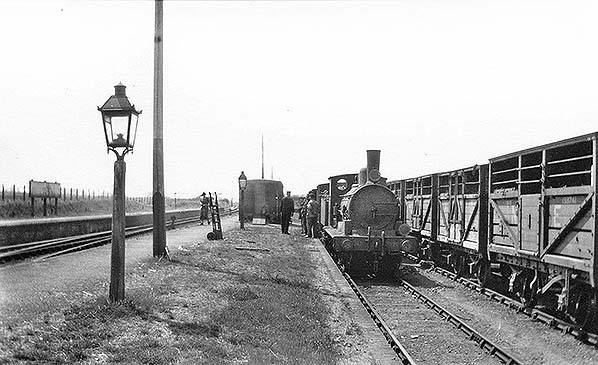

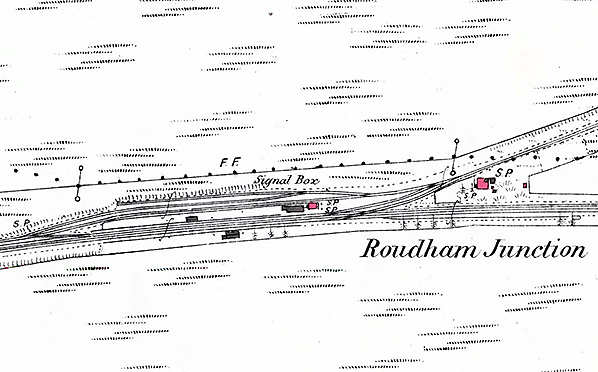
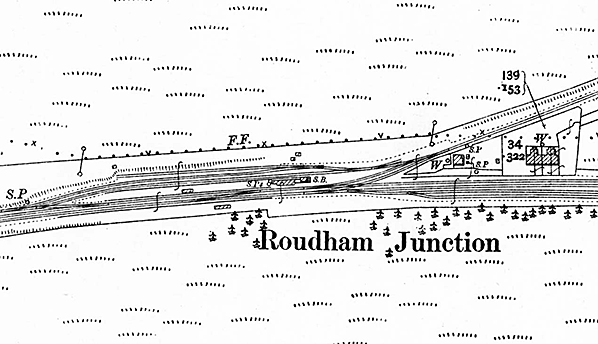
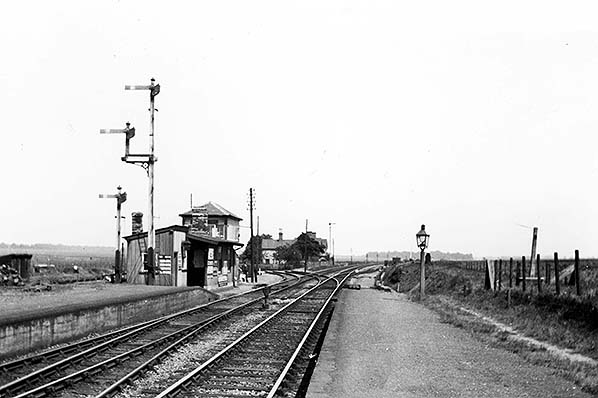
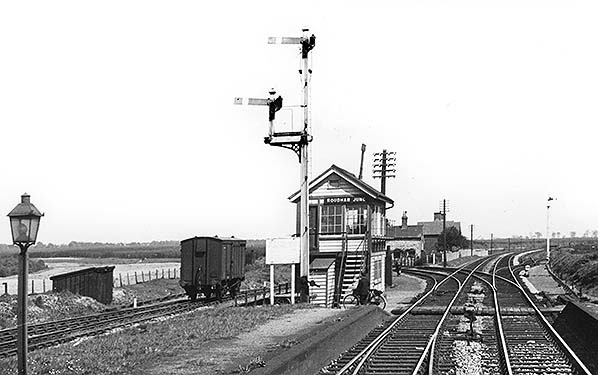
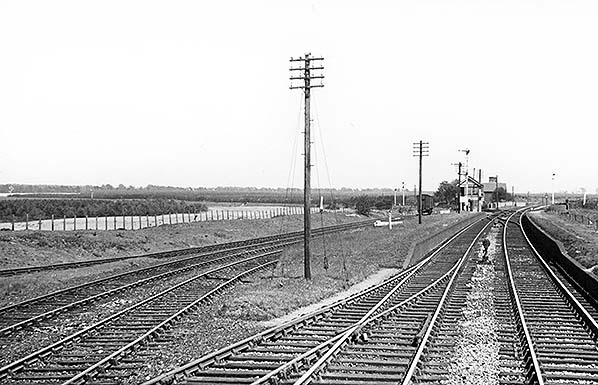
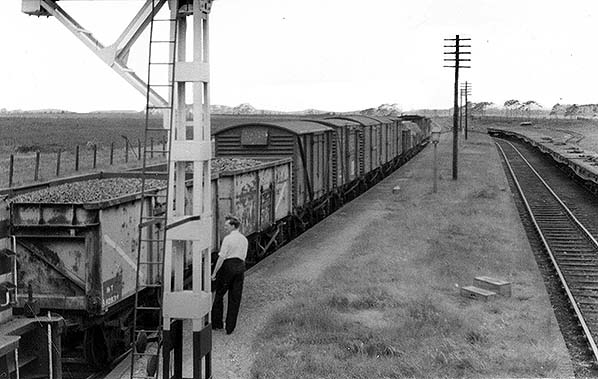
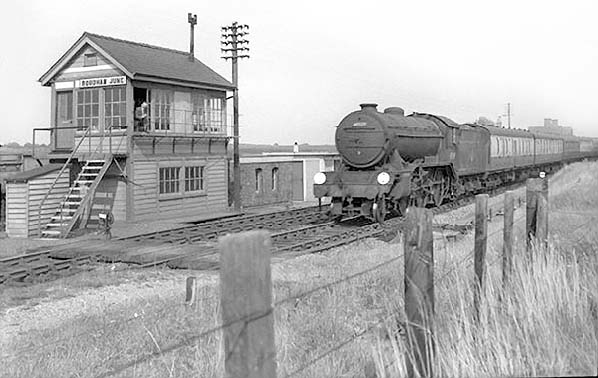
 From 1 October 1902 Roudham Junction was advertised as an exchange station only, to be used by passengers changing trains to or from the branch line. The 1882 and 1905 OS 25in Maps show the layout of the station, as a junction, in some detail. The station lay in an east:west direction. On the south side of the main line there was a platform with a small building that was probably a shelter. The other platforms were on each side of an island on the north side of the main line. A large signal box was constructed at the east end of the island. Beside it, seen in photographs from the 1920s, was a smaller building to its west, adorned with advertisements, that probably served as the station office.; this building had gone by the 1950s. Access for trains using the branch line was from the west, the Thetford direction. Through trains heading to and from the branch had to use the main line platforms. Trains from the Swaffham line terminating at Roudham Junction could use the north side of the island which did not have direct main line access for through trains. This platform did not have as good a finished surface as those serving the main line which suggests that it was little used by passenger trains. This platform’s line went into a head-shunt from which there was access to a run-round loop on the north side or to the main line in an easterly direction. There was also a siding that was shunted from the branch. Just to the east of the station another siding lay alongside the up main line entered from a trailing point. The branch left the main line platforms as double track but that lasted a very short distance before becoming single line. In the ‘Y’ formed by the junction there was a row of railway cottages. The platforms were lit by oil lamps.
From 1 October 1902 Roudham Junction was advertised as an exchange station only, to be used by passengers changing trains to or from the branch line. The 1882 and 1905 OS 25in Maps show the layout of the station, as a junction, in some detail. The station lay in an east:west direction. On the south side of the main line there was a platform with a small building that was probably a shelter. The other platforms were on each side of an island on the north side of the main line. A large signal box was constructed at the east end of the island. Beside it, seen in photographs from the 1920s, was a smaller building to its west, adorned with advertisements, that probably served as the station office.; this building had gone by the 1950s. Access for trains using the branch line was from the west, the Thetford direction. Through trains heading to and from the branch had to use the main line platforms. Trains from the Swaffham line terminating at Roudham Junction could use the north side of the island which did not have direct main line access for through trains. This platform did not have as good a finished surface as those serving the main line which suggests that it was little used by passenger trains. This platform’s line went into a head-shunt from which there was access to a run-round loop on the north side or to the main line in an easterly direction. There was also a siding that was shunted from the branch. Just to the east of the station another siding lay alongside the up main line entered from a trailing point. The branch left the main line platforms as double track but that lasted a very short distance before becoming single line. In the ‘Y’ formed by the junction there was a row of railway cottages. The platforms were lit by oil lamps. 

 Although not a large town, Watton has a long-established market having received its Charter in 1204 allowing a market to be held on Wednesdays. The coming of the railway invigorated business in the town and two large monthly cattle markets brought livestock traffic to the railway. Like many of East Anglia’s railways it was agriculture that generated much of the goods traffic. From Watton went poultry, butter, milk and eggs, principally to Cambridge and London markets. Coal and other produce not locally available arrived by train.
Although not a large town, Watton has a long-established market having received its Charter in 1204 allowing a market to be held on Wednesdays. The coming of the railway invigorated business in the town and two large monthly cattle markets brought livestock traffic to the railway. Like many of East Anglia’s railways it was agriculture that generated much of the goods traffic. From Watton went poultry, butter, milk and eggs, principally to Cambridge and London markets. Coal and other produce not locally available arrived by train..gif)
 The British Railways Board published Dr Richard Beeching’s report The Reshaping of Britain’s Railways on 27 March 1963. By 20 September of that year the Eastern Region had published proposals to close the Thetford to Watton Branch, allowing two months for consultation and objections. With what may seem like undue haste Ernest Marples, Minister of Transport, received a report on 9 January 1965 and gave his consent to closure on 27 February. The line closed on 15 June 1964. The last passenger service, the 9.21 pm from Thetford to Swaffham, ran on 12th June 1964 and was formed of a two-car diesel multiple unit with driver David Grant of Dereham in charge, carrying, it was reported locally, seventy passengers. Roudham Junction to Watton closed completely. The line north of Watton closed finally on 19 April 1965. The last train carried in coal and took away a sugar-beet harvest. Rails were removed soon after.
The British Railways Board published Dr Richard Beeching’s report The Reshaping of Britain’s Railways on 27 March 1963. By 20 September of that year the Eastern Region had published proposals to close the Thetford to Watton Branch, allowing two months for consultation and objections. With what may seem like undue haste Ernest Marples, Minister of Transport, received a report on 9 January 1965 and gave his consent to closure on 27 February. The line closed on 15 June 1964. The last passenger service, the 9.21 pm from Thetford to Swaffham, ran on 12th June 1964 and was formed of a two-car diesel multiple unit with driver David Grant of Dereham in charge, carrying, it was reported locally, seventy passengers. Roudham Junction to Watton closed completely. The line north of Watton closed finally on 19 April 1965. The last train carried in coal and took away a sugar-beet harvest. Rails were removed soon after.




 Home Page
Home Page